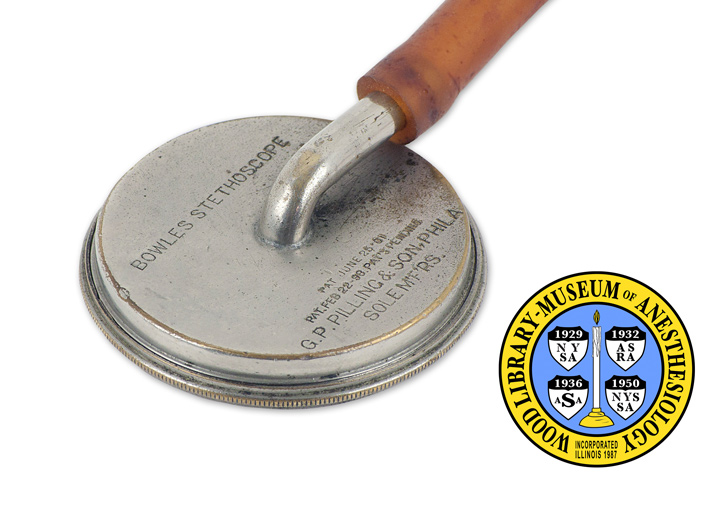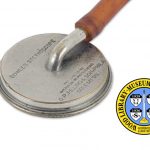Bowles Stethoscope
Our records suggest that this stethoscope was originally owned and used by Dr. Harvey Cushing (1869-1939). Cushing was an extremely accomplished neurosurgeon who had his patients’ physiologic status closely monitored during surgery. Thorough and systematic monitoring during anesthesia and surgery was not yet standard practice during Cushing’s time. He used a stethoscope devised by Robert C. M. Bowles as the very first intraoperative heart and lung monitor.
Bowles’ stethoscope improved upon its predecessors by providing better sound and a non-compressible stem (the part that connects to the tubing). Stems made of compressible material, like flexible rubber, could be bent. This interrupted sound to the earpieces. In his patent, Bowles noted that the incompressible stem allowed physicians to listen for heart and lung sounds without requiring patients to remove their clothing (A useful feature during the modest Victorian era). It would have also been useful when trying to monitor an anesthetized patient without disrupting the surgical team. Bowles applied to patent the original version of his stethoscope in 1894. The patent was granted in 1901. Four of his other modifications were patented by 1904. It is interesting to compare this stethoscope to the Bazzi-Bianchi Phonendoscope which was introduced just a few years earlier.
Catalog Record: Bowles Stethoscope
Access Key: aijv
Accession No.: 1991-11-14-1 B
Title: Bowles stethoscope / [designed by Robert C.M. Bowles.]
Author: Bowles, Robert C.M.
Title variation: Alt Title
Title: Cushing Bowles Precordial.
Publisher: Philadelphia, Pa. : G.P. Pilling & Son, [1898-190-?].
Physical Description: 1 stethoscope chest piece : nickel plated brass? ; 1.6 x 5.1 dia. cm.
Subject: Stethoscopes.
Subject: Monitoring, Intraoperative.
Subject: Auscultation – instrumentation.
Subject: Physical Examination – instrumentation.
Subject: Cushing, Harvey, 1869-1939.
Note Type: General
Notes: Bowles RCM, inventor. Stethoscope. US patent 677,172. June 25, 1901.
Note Type: General
Notes: Erickson, JC. Anesthesia, Respiration and the Stethoscope. ASA Newsl.
2002;66(9):9-10.
Note Type: Physical Description
Notes: Metal (possibly nickel plated brass) stethoscope chestpiece of compact
height; the metal stem is curved to extend parallel to the plane of the
diaphragm, and is joined to the center back of the chestpiece; The diaphragm
side is concave in shape; Diaphragm missing; Markings engraved into back:
[above the stem] “Bowles Stethoscope” [below stethoscope] “PAT June 25 . 01”
[new line] “PAT Feb 22-99 PAT’s Pending” [new line] “G.P. Pilling & Son,
Phila Sole MFRS”.
Note Type: Reproduction
Notes: Photographed by Mr. William Lyle July 13, 2010.
Note Type: Acquisition
Notes: Donated to the WLM by George S. Bause, M.D.
Note Type: Historical
Notes: WLM records suggests that this stethoscope was originally owned and used by
Harvey Williams Cushing. Dr. Cushing strongly believed in closely monitoring
a patient’s physiologic status during surgery. He used a Bowles stethoscope
as the very first intraoperative precordial monitor.
Note Type: Historical
Notes: The Bowles stethoscope marked an advance in stethoscope design by providing
“improved amplification of higher frequency sounds” (Erickson, 2002). It
also had a non-compressible stem. Stems made of compressible material could
be bent. This interrupted sound to the earpieces. In the patent, Bowles noted
that the incompressible stem allowed physicians to listen for heart and lung
sounds without requiring patients to remove their clothing (1901). A useful
feature during the modest Victorian era. It also would have been useful when
attempting to monitor an anesthetized patient without disrupting the surgical
team. Bowles applied to patent the original version of his stethoscope in 1894. The
patent was granted in 1901. Four of his other modifications were also patented by 1904.
It is interesting to compare this stethoscope to the Bazzi-Bianchi Phonendoscope which
was introduced just a few years earlier.




